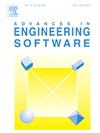CH:ALK - Rapid automatic labeling toolkit to develop training images for concrete damage segmentation models
IF 5.7
2区 工程技术
Q2 COMPUTER SCIENCE, INTERDISCIPLINARY APPLICATIONS
引用次数: 0
Abstract
With the growing demand for automated structural inspection due to the aging of civil infrastructure, deep segmentation models have been increasingly adopted with the imaging of structures. However, training the models using common supervised learning requires labeled data, and traditional manual labeling is labor-intensive, inconsistent, and time-consuming. This study introduces CH:ALK (Concrete Highlighter: Accelerated Labeling Toolkit), a rapid labeling toolkit designed to produce fast, accurate, and consistent training images for supervised learning of damage segmentation models. CH:ALK integrates automatic labeling (AL) using pre-trained CGNet (Context-Guided Network) and SAM (Segment Anything Model) to label four types of concrete damage: cracks, efflorescence, rebar exposure, and spalling. CH:ALK supports pixel-level AL that can be followed by manual correction via brush tools in an intuitive GUI. Performance validation using 80 images labeled by four users demonstrated an average time reduction of 87.97 %, accuracy of 67.07 % (mIoU), and inter-user consistency of 78.44 %, compared with traditional manual labeling (ML). Furthermore, two segmentation models, CGNet and DeepLabV3+, trained with AL data showed comparable performance to those trained with ML data. CH:ALK offers a scalable solution for developing high-quality labeled datasets for civil infrastructure inspection.
用于开发混凝土损伤分割模型的训练图像的快速自动标记工具包
随着民用基础设施老化对自动化结构检测的需求日益增长,随着结构的成像,深度分割模型被越来越多地采用。然而,使用普通监督学习训练模型需要标记数据,而传统的手动标记是劳动密集型的,不一致的,并且耗时。本研究介绍了CH:ALK (Concrete Highlighter: Accelerated Labeling Toolkit),这是一个快速标记工具包,旨在为损伤分割模型的监督学习生成快速、准确和一致的训练图像。CH:ALK集成了自动标记(AL),使用预训练的CGNet(上下文引导网络)和SAM(任何部分模型)来标记四种类型的混凝土损伤:裂缝、风化、钢筋暴露和剥落。CH:ALK支持像素级人工智能,可以在直观的GUI中通过画笔工具进行手动校正。使用4个用户标记的80张图像进行性能验证,与传统的手动标记(ML)相比,平均时间减少了87.97%,准确率为67.07% (mIoU),用户间一致性为78.44%。此外,用人工智能数据训练的两种分割模型CGNet和DeepLabV3+的性能与用ML数据训练的模型相当。CH:ALK为开发用于民用基础设施检查的高质量标记数据集提供了可扩展的解决方案。
本文章由计算机程序翻译,如有差异,请以英文原文为准。
求助全文
约1分钟内获得全文
求助全文
来源期刊

Advances in Engineering Software
工程技术-计算机:跨学科应用
CiteScore
7.70
自引率
4.20%
发文量
169
审稿时长
37 days
期刊介绍:
The objective of this journal is to communicate recent and projected advances in computer-based engineering techniques. The fields covered include mechanical, aerospace, civil and environmental engineering, with an emphasis on research and development leading to practical problem-solving.
The scope of the journal includes:
• Innovative computational strategies and numerical algorithms for large-scale engineering problems
• Analysis and simulation techniques and systems
• Model and mesh generation
• Control of the accuracy, stability and efficiency of computational process
• Exploitation of new computing environments (eg distributed hetergeneous and collaborative computing)
• Advanced visualization techniques, virtual environments and prototyping
• Applications of AI, knowledge-based systems, computational intelligence, including fuzzy logic, neural networks and evolutionary computations
• Application of object-oriented technology to engineering problems
• Intelligent human computer interfaces
• Design automation, multidisciplinary design and optimization
• CAD, CAE and integrated process and product development systems
• Quality and reliability.
 求助内容:
求助内容: 应助结果提醒方式:
应助结果提醒方式:


